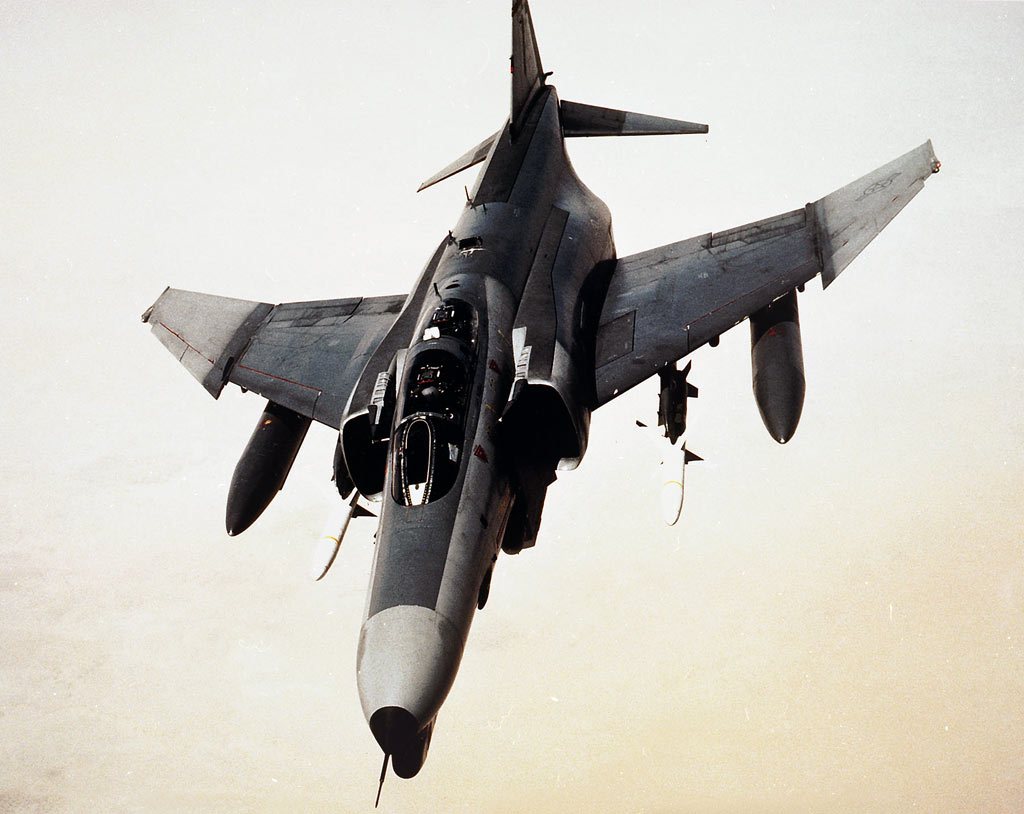The F-4G Wild Weasel
The F-4E, the most advanced Phantom II version with an internal gun and a wide range of ground assault capabilities, served as the basis for the F-4G Wild Weasel V, also called the Advanced Wild Weasel. This upgrade included a cockpit update for the rear seat to handle the electronic battle environment, as well as the removal of the gun and replacement with the APR-38(t) Radar Homing and Warning Receiver (later improved to the APR-47). A total of 134 F-4G models were converted from F-4Es with the first one flying in 1975. Squadron service began in 1978.
F-4Gs were deployed to three active wings. One was stationed at George AFB, Victorville, California, as part of the Rapid Deployment Force; one wing was assigned to USAFE (US Air Forces in Europe) at Spangdahlem AB, Germany; and the other to PACAF (Pacific Air Forces) at Clark AB, Philippines. F-4Gs from George AFB, Clark AB, and Spangdahlem AB saw combat during Operation Desert Storm in 1991, successfully protecting strike packages from enemy air defenses.
The F-4G operated with other F-4Gs or as a hunter aircraft, directing fighter-bombers, such as the F-16, against SAM sites while carrying AGM-88A/B/C High-Speed Anti-Radiation Missiles (HARM). The F-4G carried a pilot and an Electronic Warfare Officer (EWO) to facilitate communication, navigate, and coordinate assaults on the SAM installations.
30 years ahead of its time in capability
“The F-4G Wild Weasel [that first flew in 1975 and was retired in 1996] was at least 30 years ahead of its time in capability,” Jim Howard, former F-4G, and EF-111A EWO, says on Quora.
“In fact, I don’t think there is a flying system today that can geolocate radars as well by itself. The modern technique is to use multiple platforms to locate radars and share this information via datalinks.
“It had ‘DC to Daylight’ frequency coverage, had 52 flat plate antennas that used digital interferometry to measure the angle of arrival of radar pulses within seconds. Knowing the angle of arrival, the APR-38/47 system could compute the range, bearing, and probable type of radar within seconds.
“The APR38/47 system monitored 360 degrees around the F-4G.
“This information was displayed to the electronic warfare officer on a plan position indicator scope (PPI). This display was essentially an ‘inverse radar’, displaying radar emitters the same way a radar displays airborne targets.
“The APR38/47 system computed attack envelopes for anti-radiation missiles and displayed this information to the crew.”
Howard continues;

F-16s technically very inferior to the F-4G Wild Weasel
“When the F-4 platform became unsupportable the Weasel mission was passed off to F-16s using a cobbled-up pod system that primarily used the AGM-88 seeker head to detect threats.
“In all ways, the F-16 Weasels were technically very inferior to the F-4G, although the F-16 as a fighter outperforms Double Ugly by orders of magnitude.
“The F-4G Weasels were spectacularly successful in Desert Storm in suppressing Surface to Air missile sites.”
He concludes;
“Although not designed for air-to-air use, one F-4G did succeed in blowing most of the tail off an airborne bomber with an AGM-88 anti-radiation missile.
“OK, it was a friendly B-52, everyone got home, the BUFF crew all got medals, and the whole thing is forgotten now. By the Weasels anyway, maybe not so much by the BUFF guys.”
Photo by U.S. Air Force

